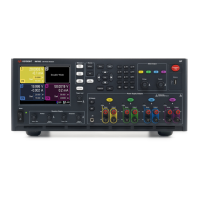TRIG:TRAN:SOUR BUS, (@1)
To select any digital pin as the trigger source:
TRIG:TRAN:SOUR EXT,(@1)
To select the immediate trigger source:
TRIG:TRAN:SOUR IMM,(@1)
To select digital pin 5 as the trigger source:
TRIG:ACQ:SOUR PIN5,(@1)
Initiate and Trigger the Elog
When the power analyzer is turned on, the trigger system is in the Idle state. In this state, the trigger
system is disabled, ignoring all triggers. The INITiate command enables the measurement system to
receive triggers. To initiate the Elog:
INIT:ELOG, (@1)
To trigger the Elog:
TRIG:ELOG, (@1)
Alternatively, if the trigger source is BUS, you can program a *TRG or an IEEE-488 <get> command.
When triggered, the Elog starts placing data in the internal measurement buffer. Because the buffer is
only large enough to hold 20 seconds of accumulated measurement your PC application must
periodically retrieve (or fetch) the data from this buffer.
Periodically Retrieve the Data
Each FETCh command returns number of requested records of the data in the buffer and removes
them, making room available for more data. The Elog continues until it is aborted. To retrieve a
maximum of 1000 records:
FETC:ELOG? 1000, (@1)
ASCII data (the default format) is returned as comma-separated ASCII numeric data sets of
average/min/max values terminated by a newline. ASCII queries can only fetch data from one channel
at a time.
Binary data is returned as a comma-separated list of data for each channel requested. The data is a
definite length binary block, with the byte order specified by the FORMat:BORDer command.
Terminate the Elog
ABOR:ELOG, (@1)
4 Using the Measurement Functions
164 Keysight N6705C Operating and Service Guide

